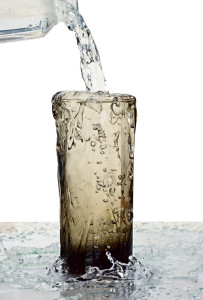
Deionization (DI) resin lifespan typically lasts 5 to 10 years. However, if any of the four primary factors cause your resin to foul prematurely, it could lead to a deterioration in your deionized water quality.
DI resin is the small bead-like substance that makes the entire water deionization process tick. It catalyzes the ion exchange that rids the water of every non-essential charged ion, creating highly purified water applicable for medical, bio or laboratory use.
However, this important job can only function properly provided the resin isn’t damaged or fouled in some way. To fully understand how this could happen, you must first know how resin works.
When resin initially enters the deionization process, it holds onto positively charged hydrogen ions (H+) and/or negatively charged hydroxyl ions (OH-).
Then, as water passes through the resin beads, all the other ions (magnesium, sulfates, etc.) stick to the resin, dislodging either the hydrogen or hydroxyl ions. This process is known as “Ion Exchange” or “Deionization.”
At the end of the process, we’re left with water that is absent of almost every charged ion except for “hydrogen hydroxyl” or pure H20.
However, as resin begins to age or become fouled from contaminants and/or improper regeneration, the ion exchange process loses its efficiency. Over time the resin beads can become fouled or damaged. If this happens, they lose their ability to hold hydrogen and hydroxyl ions, hindering the ion exchange process.
Here are the primary factors that can foul DI resin and/or lead to lower capacities.
4 Factors That Shorten DI Resin Lifespan
1. Water high in chlorine or chloramines
Higher than average amounts of chlorine or chloramines from the incoming treated water can break down DI resin. Over time, constant exposure to higher amounts of chlorine will begin to break the resin down from a cylindrical bead to a combined substance that looks and feels like a “mush” of resin.
2. Water high in iron content or debris
Similar to chlorine, trace amounts of iron or debris can also foul high purity resin.
If the resin is not regenerated correctly after picking up any of these contaminants, resin can become fouled. If the resin becomes fouled, it greatly reduces the capacity of the resin, ultimately driving up the deionization costs to the end user.
3. High frequency of regeneration
Choosing a set of deionizers that meet your facilities capacity requirements helps ensure longer lasting resin.
A set of deionizers that meet your facility’s needs for a couple of days are normally not as cost effective as a set of deionizers that meet your capacity needs for a month.
4. Mixing resins together
This is a precarious practice that many water treatment vendors (excluding ourselves) regularly commit. Many water treatment companies will remove the resin from multiple (sometimes up to 20 or 30) exchange canisters, mix it all together and regenerate it together.
This process is called batch regeneration. After the batch regeneration is completed the resin is redistributed back into the 20-30 exchange canisters.
Here’s the problem: If two or three of the 20-30 deionization canisters contain fouled resin that requires additional attention, it’s impossible to handle during the batch regeneration process. The fouled resin will not get treated properly, and ultimately reduces the resin quality of the other 20-30 deionizers in the batch process.
That’s why Total Water never mixes resin. Instead, we keep the same resin in each canister for the entire lifespan of the deionizer. If we identify any canisters with fouled resin, we treat that resin appropriately or discard it without affecting the quality of the other resins.
This single tank regeneration process enables us to provide our customers full traceability for each deionizer and its resin.
Warning Signs of Expired or Fouled Resin
Fortunately, it isn’t difficult to recognize fouled or expired resin. Every deionizer is equipped with some sort of water quality monitoring system – be it a digital meter or a simple water quality light system.
A “red light/green light” system is the simplest, albeit least informative, water quality monitoring system. When the water quality drops below a certain resistance level, the monitor’s light changes from green to red. At that point, you can call a water treatment service to exchange your deionization tanks.
Another option is off-site monitoring, where a water treatment service will monitor your system for you. Then, if the water quality drops below a certain resistance set point, an on-site service can be arranged.
A final, more specific way to monitor your resin’s effectiveness is with a digital water quality meter. If you have a digital meter, ensure that it’s calibrated correctly every year. We’ve experienced customers who falsely believe their deionized water is meeting the necessary quality standards, when in fact, an incorrect calibration was misleading them.
Given its importance in the deionization process, ensuring your high purity DI isn’t expired or fouled is crucial. If your deionization system indicates any drop in water quality, contact us to see if resin could be your issue.
We’ll do more than give you a quote—we’ll visit your site to analyze your industrial water needs.

Follow Us